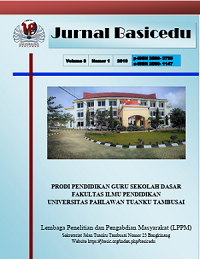Pengembangan Media Bigbook Pada Pembelajaran Membaca Pemahaman Siswa Kelas 1 di Sekolah Dasar
DOI:
https://doi.org/10.31004/basicedu.v7i4.5575Keywords:
Media bigbbok, membaca pemahaman, penelitian pengembanganAbstract
References
Agussani, M., & Ap. (2020). PROGRAM PENDIDIKAN KEAKSARAAN BERBASIS KECAKAPAN HIDUP.
Anggia Nastitie Ariawan, V., & Tri Utami, N. (2018). PENINGKATAN KETERAMPILAN MEMBACA PEMAHAMAN SISWA SEKOLAH DASAR MELALUI IMPLEMENTASI MODEL CIRC BERBANTUAN MEDIA CETAK. Journal of Islamic Primary Education, 1(2), 95–104. http://journal.uinsgd.ac.id/index.php/al-aulad
Cahyadi, R. A. H. (2019). Pengembangan Bahan Ajar Berbasis Addie Model. Halaqa: Islamic Education Journal, 3(1), 35–42. https://doi.org/10.21070/halaqa.v3i1.2124
Evy, C., & Widyahening, T. (n.d.). PENGGUNAAN TEKNIK PEMBELAJARAN FISHBONE DIAGRAM DALAM MENINGKATKAN KETERAMPILAN MEMBACA SISWA.
Fadillah, A. (2019). Analisis Kemampuan Penalaran Deduktif Matematis Siswa. JTAM | Jurnal Teori Dan Aplikasi Matematika, 3(1), 15. https://doi.org/10.31764/jtam.v3i1.752
Febrianto, R., & Puspitaningsih, F. (2020). PENGEMBANGAN BUKU AJAR EVALUASI PEMBELAJARAN. Education Journal : Journal Educational Research and Development, 4(1), 1–18. https://doi.org/10.31537/ej.v4i1.297
Hadiana, L. H., Hadad, S. M., Marlina, I., & Subang, S. (2018). PENGGUNAAN MEDIA BIG BOOK UNTUK MENINGKATKAN KETERAMPILAN MEMBACA KALIMAT SEDERHANA. In Jurnal Pendidikan Guru Sekolah Dasar (Vol. 2).
Heri Susanto. (n.d.). Buku Profesi Keguruan.
M Faadhilah Suhandi, S. A. (n.d.). Pendidikan Anti Korupsi Pada Jenjang Perguruan Tinggi.
Mahsun, M., & Koiriyah, M. (n.d.). MENINGKATKAN KETERAMPILAN MEMBACA MELALUI MEDIA BIG BOOK PADA SISWA KELAS IA MI NURUL ISLAM KALIBENDO PASIRIAN LUMAJANG.
Mohamad Johan, G., Dyoty Auliya Vilda Ghasya, dan, & Bina Bangsa Getsempena, S. (2018). PENGEMBANGAN MEDIA LITERASI BIG BOOK UNTUK MENINGKATKAN KETERAMPILAN MEMBACA PEMAHAMAN SISWA SEKOLAH DASAR. In Jurnal Tunas Bangsa (Vol. 5, Issue 2).
Muqdamien, B., Puji Raraswaty, D., & Sultan Maulana Hasanuddin Banten, U. (2021). TAHAP DEFINISI DALAM FOUR-D MODEL PADA PENELITIAN RESEARCH & DEVELOPMENT (R&D) ALAT PERAGA EDUKASI ULAR TANGGA UNTUK MENINGKATKAN PENGETAHUAN SAINS DAN MATEMATIKA ANAK USIA 5-6 TAHUN 1*. Jurnal, 6(1).
Mutji, E., & Suoth, L. (2021). LITERASI BACA TULIS PADA KELAS TINGGI DI SEKOLAH DASAR. Jurnal Ilmiah Pendidikan Citra Bakti, 8(1), 103–113. https://doi.org/10.38048/jipcb.v8i1.133
Nur Rizky Toybah. (n.d.). Dakwah Komunikasi Visual Melalui Instagram Akun @HADITSKU.
Perbanas, D. (n.d.). Dosen Perbanas Sarana tukar menukar informasi dan pemikiran dosen Regresi Data Panel (2) “Tahap Analisis.†http://dosen.perbanasinstitute.ac.id
Prasetyo, I. (n.d.). TEKNIK ANALISIS DATA DALAM RESEARCH AND DEVELOPMENT.
Riani, N., & Chrysti Suryandari, K. (n.d.). Kalam Cendekia: Jurnal Ilmiah Kependidikan.
Sandi, S., Lubis, W., Ar-Raniry, U., Pgmi, P., & Aceh, B. (n.d.). Sastra dan Pengajarannya (PEDALITRA I) Penguatan Literasi Melalui Pengajaran Bahasa dan Sastra 27 Oktober 2021 PBID, FKIP. In Universitas PGRI Mahadewa Indonesia (Vol. 212).
Sayu Putri Ningrat, I. M. T. M. S. (n.d.). Kontribusi Gaya Belajar Dan Motivasi Belajar Terhadap Hasil Belajar Bahasa Indonesia.
Tindaon, Y. A. (n.d.). PEMBELAJARAN SASTRA SEBAGAI SALAH SATU WUJUD IMPLEMENTASI PENDIDIKAN BERKARAKTER.
Downloads
Published
How to Cite
Issue
Section
Citation Check
License
Authors who publish with this journal agree to the following terms:
- Authors retain copyright and grant the journal right of first publication with the work simultaneously licensed under a Creative Commons Attribution License that allows others to share the work with an acknowledgement of the work’s authorship and initial publication in this journal.
- Authors are able to enter into separate, additional contractual arrangements for the non-exclusive distribution of the journal’s published version of the work (e.g., post it to an institutional repository or publish it in a book), with an acknowledgement of its initial publication in this journal.
- Authors are permitted and encouraged to post their work online (e.g., in institutional repositories or on their website) prior to and during the submission process, as it can lead to productive exchanges, as well as earlier and greater citation of published work (See The Effect of Open Access).



